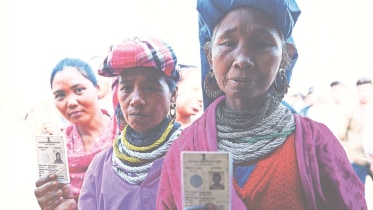By Ritwik Sharma
As a region that is at the margins, both geographically and in the national imagination, the northeast is often viewed as one bloc. One that is racially distinct from —and consequently othered by—the rest of India. While that has always bred a sense of the Indian state neglecting the seven sisters (and a ‘brother’ state of Sikkim), the reality of internecine struggles within them and among the mosaic of tribal and non-tribal communities tends to get muted.
An anthology titled But I am One of You: Northeast India and the Struggle to Belong, edited by Samrat Choudhury and Preeti Gill, manages to shed some light on those who are ‘outsiders’ in the northeast. The book does have accounts of racial prejudices and insensitivity faced by the average migrant from the northeast in a city like New Delhi. But what the collection of essays strongly conveys is that just as people from the northeast, especially tribals, feel alienated in the Indian mainland, communities who have migrated to the region ages ago or are simply not part of the dominant group in a state are unequal citizens.
In that sense, it is furthering a project that Choudhury and Gill began in 2019, with Insider Outsider: Belonging and Unbelonging in North-East India (Amaryllis), at a time the fateful and futile update of the National Register of Citizens (NRC) was ongoing in Assam. Now, Manipur is burning in ethnic strife for more than a year. In this context, an article on the turn of events and written by someone from either of the conflicting communities in Manipur—Meitei and Kuki-Zo—would have been a timely and valuable addition to the new volume.
It has 18 articles that touch upon all eight states. Choudhury and Gill observe in the introduction: “The insider in one place becomes the outsider in another. The experience of simultaneously being both an insider and an outsider is thus part of an increasingly universal experience.”
These positions, which can change depending on one’s location, are reflected in the personal stories told by some of the contributors. For instance, Indira Laisram writes about “navigating my identity as a Cachar Meitei”, that is a non-resident Manipuri with roots in Assam, while she grew up and “felt more at home in Shillong”—the sense of belonging aided by her physical appearance in a city that could be hostile to the “dkhar” (local term for non-Khasis). Living in Delhi as a professional later, she negotiates a “paradoxical feeling of belonging and unbelonging at the same time”. Makepeace Sitlhou, a Kuki who similarly grew up away from Manipur in army cantonments, explains: “Like in a true Pavlovian understanding of human behaviour, we were rewarded for playing the good minority in a foreign land, while being mocked and criticised for being terrible natives in our own land.”
A few of the articles fail to be compelling when the writers merely recount experiences that are but familiar or address identity concerns with a universalising, generic lens. And while talking identity politics, it is fine for a member of a dominant community to write about ‘outsiders’ in an empathetic manner because self-reflection is much needed in an extremely heterogeneous society. Besides, essays gazing inwards at one’s own state or ethnic group are insightful. Ramona Sangma offers a sharp critique of Garo society, including its vaunted matrilineal claims. “To the uninitiated, matriliny is not the exact opposite of patriarchy. If it were, it would be far simpler,” she says, and that “…the role of a woman in a Garo household is like any other woman elsewhere in the world.”
Patricia Mukhim dwells on the insider-outsider equations in Meghalaya, and bemoans the damaging insularity of a “state of unequal citizens”. Like her, fellow veteran journalist Subir Bhaumik diagnoses the problems facing the people of Tripura, where the indigenous tribes became a minority within two decades of Partition. He lays out a roadmap for reconciliation while suggesting that “…the present ethnic conflict that pits the Bengali settlers against the indigenous tribespeople in Tripura has much to do with the large-scale alienation of tribals because land is seen not only as the prime economic resource in a rather backward pre-capitalist society like Tripura but also as the symbol of ethnic preponderance…”
More than finding answers, the anthology aims to challenge stereotypical notions and provide “a platform for voices that may have been silenced, ignored or overlooked”. That is where it engages the reader the most—with stories of Pangals (Muslim Meiteis) in Manipur, Gorkhas in Mizoram, tribal women in Tripura and how clothing shaped their politics, a fifth-generation Marwari in Meghalaya, and an elderly in a Bengali family being turned into a ‘doubtful voter’ decades after being identified in the 1951 NRC or the bias against the Bodos in Assam.
